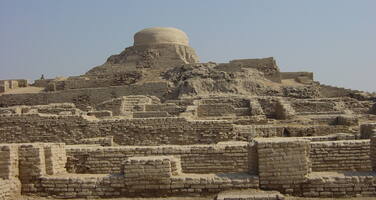Archaeological Ruins at Moenjodaro
Factors affecting the property in 1997*
- Flooding
- Impacts of tourism / visitor / recreation
- Water (rain/water table)
- Other Threats:
Deterioration of the bricks due to salt crystallization and hydration
Factors* affecting the property identified in previous reports
- Flooding and lowering of the ground water table
- Impacts of tourism/visitor
- Deterioration of the bricks due to salt crystallization and hydration
International Assistance: requests for the property until 1997
Total amount approved : 79,000 USD
| 1995 | Updating of the Tentative List and revision of the ... (Approved) | 11,000 USD |
| 1983 | 6-month fellowship for the Head of the Moenjodaro ... (Approved) | 14,000 USD |
| 1982 | Training and equipment for a conservation laboratory ... (Approved) | 34,000 USD |
| 1982 | Workshop seminar at Moenjodaro on the conservation of ... (Approved) | 20,000 USD |
Missions to the property until 1997**
Information presented to the Bureau of the World Heritage Committee in 1997
The Bureau took note of the information provided by the Secretariat concerning the conclusion of the International Campaign for the Safeguarding of Moenjodaro.
Action Required
Conservation issues presented to the World Heritage Committee in 1997
The excavated remains of this site continue to be threatened by the environment. The US$ 24 million International Campaign for the Safeguarding of Moenjodaro, launched by UNESCO and the Government of Pakistan in 1974, was concluded in September 1997. The Campaign’s International Advisory Committee, at its final meeting, made recommendations to the Government of Pakistan to create an administrative structure to manage the site with assistance from international experts.
Summary of the interventions
Decisions adopted by the Committee in 1997
21 COM VII.C.55
Reports on the state of conservation of cultural properties noted by the Committee
VII.55 The Committee noted the decisions of the twenty-first extraordinary session of the Bureau on the following cultural properties as reflected in the report of the Bureau session, Working Documents WHC-97/CONF.208/4B Section III.C.c):
Joya de Ceren Archaeological Site (El Salvador)
Le Canal du Midi (France)
Mont-Saint-Michel and its Bay (France)
Ashanti Traditional Buildings (Ghana)
Maya Site of Copan (Honduras)
Agra Fort, Taj Mahal, Fatehpur Sikri (India)
Quseir Amra (Jordan)
Town of Luang Prabang (Lao People's Democratic Republic)
Pre-Hispanic City of Teotihuacan (Mexico)
Ilha de Mozambique (Mozambique)
Moenjodaro (Pakistan)
Baroque Churches of the Philippines (Philippines)
Old Town of Segovia and its Aqueduct (Spain)
Cultural World Heritage sites in Sri Lanka
Ancient City of Damascus (Syrian Arab Republic)
Historic Areas of Istanbul (Turkey)
Itchan Kala, Historic Centre of Bukhara (Uzbekistan)
Shibam and Zabid (Yemen).
The Bureau may wish to adopt the following text and transmit it to the Committee for noting:
"The Bureau takes note of the information provided by the Secretariat concerning the conclusion of the International Campaign for the Safeguarding of Moenjodaro, and request[s] the Government of Pakistan to keep the Secretariat informed on the implementation of the final recommendations of the International Advisory Committee."
* :
The threats indicated are listed in alphabetical order; their order does not constitute a classification according to the importance of their impact on the property.
Furthermore, they are presented irrespective of the type of threat faced by the property, i.e. with specific and proven imminent danger (“ascertained danger”) or with threats which could have deleterious effects on the property’s Outstanding Universal Value (“potential danger”).
** : All mission reports are not always available electronically.


